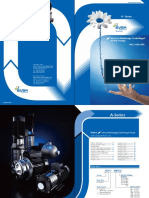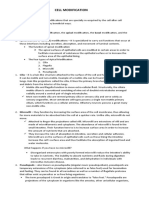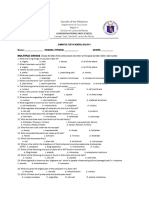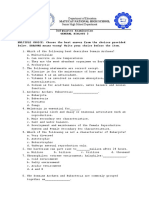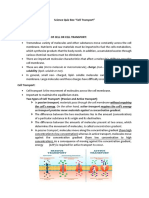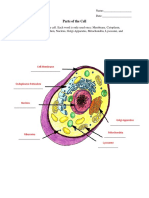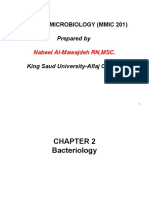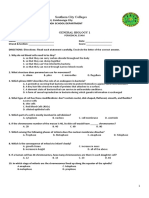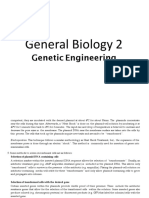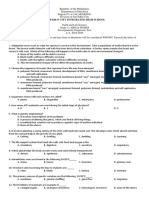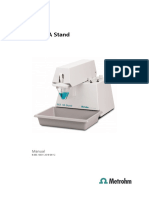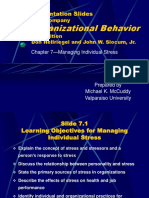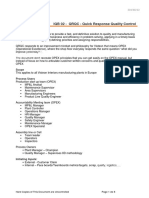0 ratings0% found this document useful (0 votes)
80 viewsApplications in Crop Improvement
Applications in Crop Improvement
Uploaded by
Maria Ella Juliana CapanangGenetic engineering involves three basic steps: (1) isolating DNA fragments from a donor organism, (2) inserting the donor DNA into a vector genome, and (3) growing the recombinant vector in a host. Most often, genetic engineering adds a gene from one species to another's genome to produce desired traits. Key applications include developing crops with increased yield, herbicide/pest resistance, and transferring nitrogen-fixing genes to cereal crops. Genetic engineering also produces medicines like antibiotics, insulin, and vaccines.
Copyright:
© All Rights Reserved
Available Formats
Download as DOCX, PDF, TXT or read online from Scribd
Applications in Crop Improvement
Applications in Crop Improvement
Uploaded by
Maria Ella Juliana Capanang0 ratings0% found this document useful (0 votes)
80 views11 pagesGenetic engineering involves three basic steps: (1) isolating DNA fragments from a donor organism, (2) inserting the donor DNA into a vector genome, and (3) growing the recombinant vector in a host. Most often, genetic engineering adds a gene from one species to another's genome to produce desired traits. Key applications include developing crops with increased yield, herbicide/pest resistance, and transferring nitrogen-fixing genes to cereal crops. Genetic engineering also produces medicines like antibiotics, insulin, and vaccines.
Original Title
GenBio2
Copyright
© © All Rights Reserved
Available Formats
DOCX, PDF, TXT or read online from Scribd
Share this document
Did you find this document useful?
Is this content inappropriate?
Genetic engineering involves three basic steps: (1) isolating DNA fragments from a donor organism, (2) inserting the donor DNA into a vector genome, and (3) growing the recombinant vector in a host. Most often, genetic engineering adds a gene from one species to another's genome to produce desired traits. Key applications include developing crops with increased yield, herbicide/pest resistance, and transferring nitrogen-fixing genes to cereal crops. Genetic engineering also produces medicines like antibiotics, insulin, and vaccines.
Copyright:
© All Rights Reserved
Available Formats
Download as DOCX, PDF, TXT or read online from Scribd
Download as docx, pdf, or txt
0 ratings0% found this document useful (0 votes)
80 views11 pagesApplications in Crop Improvement
Applications in Crop Improvement
Uploaded by
Maria Ella Juliana CapanangGenetic engineering involves three basic steps: (1) isolating DNA fragments from a donor organism, (2) inserting the donor DNA into a vector genome, and (3) growing the recombinant vector in a host. Most often, genetic engineering adds a gene from one species to another's genome to produce desired traits. Key applications include developing crops with increased yield, herbicide/pest resistance, and transferring nitrogen-fixing genes to cereal crops. Genetic engineering also produces medicines like antibiotics, insulin, and vaccines.
Copyright:
© All Rights Reserved
Available Formats
Download as DOCX, PDF, TXT or read online from Scribd
Download as docx, pdf, or txt
You are on page 1of 11
(1) PROCESSES INVOLVED IN GENETIC techniques.
There are several steps in the process
ENGINEERING of genetic engineering. Scientist follow a step-by-
step process in order to alter the DNA of an
The process of genetic engineering is not a
organism.
simple task, it requires complex machinery and
innovative minds. Since farming began, humans As shown in Figure 1, the first stage of the
have been selectively breeding different plants, process is to identify the section of DNA that
doing so provided more food and better food for all. contains required gene from the source
This process is genetic engineering in much chromosome. Second stage, extract the required
simpler terms than we think of it today. gene. Third stage, bacterial plasmid is removed
from the bacterial cell and cut open using enzymes.
In simple perspective, genetic engineering
Fourth stage, insert plasmid into host cell and
is the process of manually transferring genetic
sealed using enzymes. Fifth stage, grow
information from one organism to another. But,
transformed cells to produce a genetically modified
when one thinks of the processes in genetic
organism (GMO).
engineering they are more likely to picture a
complicated science which involves altering the Genetic engineering involves the direct
very building blocks of life. manipulation of one or more genes. Most often, a
gene from another species is added to an
Genetic engineering is accomplished in
organism's genome to give it a desired phenotype.
three basic steps:
Application of Recombinant DNA
(1) The isolation of DNA fragments from a
donor organism; The introduction of recombinant DNA
(2) The insertion of an isolated donor DNA technology paved the way in developing different
fragment into a vector genome and concepts and interventions in the field of biology.
(3) The growth of a recombinant vector in an Because of the different problems occurred in the
appropriate host. society, people began to discover many things to
lessen the problems encountered. This is the
reason why such developments were done. Below
are the important applications of recombinant DNA
technology. It includes (1) applications in crop
improvement, (2) applications in medicines and (3)
industrial applications.
Applications in Crop Improvement
In crop improvement, development of
different genetically modified crops improved both
yield and resistance to pests and weeds.
1. Distant Hybridization. Due to genetic
engineering, it is now possible to transfer
genes between distantly related species.
The barriers of gene transfer between
The Process of Genetic Engineering species or even genera have been
Genetic engineering is the process of using overcome. Through the recombinant DNA
recombinant DNA (rDNA) technology to alter the technology, the desirable genes can be
genetic makeup of an organism. Traditionally, transferred even from lower organisms to
humans have manipulated genomes indirectly by higher organisms.
controlling breeding and selecting offspring with 2. Development of Transgenic Plants.
desired traits. Genetic engineering involves the Transgenic plants are genetically
direct manipulation of one or more genes. Most transformed plants which contain foreign
often, a gene from another species is added to an genes. Resistance to diseases, insects and
organism's genome to give it a desired phenotype. pests, herbicides, drought; metal toxicity
tolerance; induction of male sterility for plant
One of the most amazing things about life breeding purpose; and improvement of
on earth which we often take for granted is that all quality can be achieved through this
life uses the same DNA code to store its recombinant DNA technology.
information and create proteins. Because all of life 3. Development of Root Nodules in Cereal
uses the same DNA code, we are now able to Crops. Rhizobium (nitrogen fixing bacteria)
combine DNA from one species with another in found in the root-nodules of leguminous
order to produce proteins in new and different ways plants converts the free atmospheric
which is revolutionizing science and medicine. The nitrogen into nitrates in the root nodules.
bacterial plasmids which you already know about The bacterial genes responsible for this
are often very crucial for these genetic engineering nitrogen fixation can be transferred now to
cereal crops like wheat, rice, maize, barley infectious agents, for instance, food
etc. through the techniques of genetic poisoning Salmonella, Pus forming
engineering thus making these crops too Staphylococcus, hepatitis virus, HIV, etc. By
capable of fixing atmospheric nitrogen. testing the DNA of prospective genetic
4. Development of C4 Plants. Improving the disorder carrier parents, their genotype can
photosynthetic efficiency of crop plants can be determined and their chances of
improve its yield. The photosynthetic rate producing an afflicted child can be
can be increased by conversion of C3 predicted.
plants into C4 plants, which can be 6. Production of Transgenic Animals.
achieved either through protoplasm fusion Animals which carry foreign genes are
or recombinant DNA technology C4 plants called transgenic animals. Cow, sheep, goat
have higher potential rate of biomass – therapeutic; human proteins in their milk.
production than C3 plants. Most C4 plants Fish like common carp, cat fish, salmon and
(sorghum, sugarcane, maize, some gold fish contain human growth hormone
grasses) are grown in tropical and (hGH)
subtropical zones.
Industrial Applications
Applications in Medicines
Biofuels derived from biomass and these
Genetic engineering plays an important role are renewable and cost effective. Genetic
in the production of antibiotics, hormones, vaccines engineering plays an important role in a beneficial
and interferon in the field of medicines. and large scale production of biofuels. It also helps
in improving the organisms for obtaining higher
1. Production of Antibiotics. Antibiotics
product yields and improve tolerance.
produced by microorganisms are very
effective against different viral, bacterial or Recombinant DNA technique will help in the
protozoan diseases. Some antibiotics are production of chemical compounds of commercial
tetracyclin, penicillin, streptomycin, importance, improvement of existing fermentation
novobiocin, bacitracin, etc. Improving the processes and production of proteins from wastes.
microbial strains through modification of This can be achieved by developing more efficient
genetic characteristics helps in increasing strains of microorganisms. Specially developed
the production of antibiotics. microorganisms may be used even to clean up the
2. Production of Hormone Insulin. The pollutants.
insulin which is a hormone used by
(2) HISTORY OF LIFE ON EARTH
diabetics is usually extracted from pancreas
of cows and pigs. This insulin is slightly One of the great mysteries in the Universe
different in structure from human insulin. It is the origin of creation. Biologists rely primarily on
leads to allergic reactions in about 5% dating the rocks in which fossils are contained and
patients. Human gene for insulin production looking at the "molecular clocks" in living
has been incorporated into bacterial DNA organisms' DNA to do this. Based on the most
and such genetically engineered bacteria accepted propositions, life started at least 3.5
are used for large scale production of billion years ago, since that's the age of the
insulin. world's oldest rocks with fossil proof of life. These
3. Production of Vaccines. Vaccines are now rocks are rare because the surface of our planet
produced by transfer of antigen coding has been reshaped by subsequent geological
genes to disease causing bacteria. Such cycles, sometimes crushing older rocks while
antibodies provide protection against the creating new ones.
infection by the same bacteria or virus.
These include vaccines for polio, malaria, Scientists have broken the Earth's 4.56-
cholera, hepatitis, rabies, smallpox, etc. billion-year history into units that represent unique
4. Production of Enzymes. Recombinant periods of time based on their interpretations of the
DNA technique can produce some useful rock record. Taken together, the geologic time
enzymes like enzyme urikinase which is scale is made up of these time periods.
used to dissolve blood clots. It has been Eons represent the greatest expanses of
produced by genetically engineered time. Eons are divided into eras. Each era is
microorganisms.
5. Diagnosis of Disease. Recombinant DNA
technology has provided a broad range of
tools to help physicians in the diagnosis of
diseases. Most of these involve the
construction of probes: short Segments of
single stranded DNA attached to a
radioactive or fluorescent marker. Such
probes are now used for identification of
subdivided into periods. Finally, periods are divided into three eras: Paleozoic, Mesozoic, and
divided into smaller units called epochs. Each Cenozoic.
period within an era is characterized by somewhat
Life in early Paleozoic time was restricted
lesser profound changes in life forms as compared
to the seas. Laurasia is the continental mass that
with the changes that occur during an era. The
formed the northern portion of Pangaea, consisting
periods of the Cenozoic era are divided into still
of present-day North America and Eurasia. By the
smaller units called epochs, during which even
end of the Paleozoic, all the continents had fused
lesser profound changes in life forms occur. During
into the supercontinent of Pangaea.
Precambrian time, there were fewer life forms.
These life forms are more difficult to identify and Some 400 million years ago, plants that had
the rocks have been disturbed often. adapted to survive at the water’s edge began to
move inland, becoming land plants. The
The eon where life began was during the
amphibians rapidly diversified because they had
Phanerozoic eon. There are three eras within the
minimal competition from other land dwellers.
Phanerozoic eon: the Paleozoic, which means
“ancient life,” the Mesozoic, which means “middle The world’s climate became very seasonal,
life,” and the Cenozoic, which means “recent life.” probably causing the dramatic extinction of many
species. The late Paleozoic extinction was the
For ease in discussion and remembering,
greatest of at least five mass extinctions to occur
the eras will be the basis of division of the history of
over the past 500 million years.
life. The following are the four eras of the origin of
life: Precambrian, Paleozoic, Mesozoic and Mesozoic Era (Age of Reptiles)
Cenozoic chronologically.
The gymnosperms quickly became the
Precambrian History dominant plants of the Mesozoic era.
Gymnosperms are seed-bearing plants that do not
The Precambrian encompasses immense
depend on free-standing water for fertilization.
geological time, from Earth’s distant beginnings
4.56 billion years ago until the start of the Cambrian The development of the shelled egg
period, over 4 billion years later. Earth’s original characterized the animal life of this era. Unlike
atmosphere was made up of gases similar to those amphibians, reptiles have shell-covered eggs that
released in volcanic eruptions today—water vapor, can be laid on the land. The elimination of a water-
carbon dioxide, nitrogen, and several trace gases, dwelling stage (like the tadpole stage in frogs) was
but no oxygen. an important evolutionary step. With the perfection
of the shelled egg, reptiles quickly became the
The oldest fossils of single-celled organisms
dominant land animals. At the end of the Mesozoic
date from 3.5 billion years ago. Some single-celled
era, many reptile groups became extinct.
organisms may be feeding on methane by this time.
At 2 billion years ago, Eukaryotic cells – cells with Cenozoic Era (Age of Mammals)
internal “organs” (known as organelles) – come into
being. One key organelle is the nucleus: the control The Cenozoic era is divided into two periods
center of the cell, in which the genes are stored in of very unequal duration, the Tertiary period and
the form of DNA. Eukaryotic cells evolved when the Quaternary period. Plate interactions during the
one simple cell engulfed another, and the two lived Cenozoic era caused many events of mountain
together, more or less amicably – an example of building, volcanism, and earthquakes in the West.
“endosymbiosis”. The engulfed bacteria eventually Mammals—animals that bear live young
become mitochondria, which provide eukaryotic and maintain a steady body temperature—replaced
cells with energy. The last common ancestor of all reptiles as the dominant land animals in the
eukaryotic cells had mitochondria – and had also Cenozoic era. Adaptations like being warm
developed sexual reproduction. blooded, developing insulating body hair, and
Later, primary plants evolved that used having more efficient heart and lungs allow
photosynthesis and released oxygen. Oxygen mammals to lead more active lives than reptiles.
began to accumulate in the atmosphere about 2.5 Angiosperms—flowering plants with
billion years ago. The most common Precambrian covered seeds—replaced gymnosperms as the
fossils are stromatolites. Stromatolites are dominant land plants.
distinctively layered mounds or columns of calcium
carbonate. They are not the remains of actual Large mammals started to become extinct
organisms but are the material deposited by algae. at the later part of the era. In North America, the
Many of these ancient fossils are preserved in chert mastodon and mammoth, both huge relatives of the
—a hard dense chemical sedimentary rock. elephant, became extinct. In addition, saber-
toothed cats, giant beavers, large ground sloths,
Early Paleozoic (Life Explodes) horses, camels, giant bison, and others died out on
Following the long Precambrian, the most the North American continent. The reason for this
recent 540 million years of Earth’s history are recent wave of extinctions puzzles scientists.
(4) MECHANISMS OF CHANGE IN Natural Selection
POPULATION
As what it expressed in Darwin’s Theory of
Mechanisms that Produces Change in natural selection in species, it encompasses the
Population phrase, “when the environment changes, natural
selection often favors different traits in a species.”
For a population to start evolving, members
Humans are significantly changing the environment
of the population should possess variations, which
in a number of ways; we therefore should not be
is the material on which agents of evolution act.
flabbergasted to see biological species that try to
Any heritable trait is a characteristic of organism
adapt to these new conditions.
that is influenced by the genes. Without any genetic
variation, the basic mechanism of evolutionary The Peppered Moth case forwarded by the
change cannot activate. biologist J.B.S. Haldane in 1924 is an excellent
example of Darwin’s Natural selection in action.
1. Mutation
The gene that controls the color of the peppered
Very occasionally, little copying alteration or moth occurs as two alleles, a melanic allele (black
change (mutations) occurs during the process of color), and a mottled allele (pale color). Pale moths
DNA replication. This may because by a number of were dominant in the country side around
factors, which include but not limited to radiation, Manchester in the early 18th century.
viruses, or carcinogens (cancer causing materials).
However, the trees on which these moths
Since the blueprint of any cell function is dictated
are resting get disturbed, altered, and were covered
by its genotype, even a minute mutation might
in black soot during Industrial Revolution. Pale
mean that the cells fail work properly.
mottled moths were poorly camouflaged on the
2. Gene Flow black tree trunks and especially eaten by birds as
food. In contrast, the black melanic moths were
A result of migrating individuals that breed better in avoiding predation. Natural selection acted
in a new location is gene flow. Genes coming from against the mottled moths while the melanic moths
the immigrants may add new alleles to the existing were dominant. However, there was one final twist.
gene pool of the population, or they may modify the As the skies became cleaner in 20th century, the
allele frequencies already present if they come from pale-colored moths returned and displace the
a population with different allele frequencies. Some melanic moths again.
events that lead to gene flow may be in pollen or
spores being disperse by air in a new location, Artificial Selection
animals hibernating and transferring to a new locale
Artificial selection is exactly the same
due to changes in temperatures, or humans moving
mechanism as natural selection but it is sort of
to new cities or countries.
controlled by human purposes rather than natural
3. Recombination forces. Even if we have been successful in shifting
the frequency of alleles in various dog breeds, we
Because of sexual reproduction, new gene have not created new species.
combination are introduced into a population; thus,
it can be an important source of genetic variation. The biological definition of species is a
As what you might already know, even siblings are population that can interbreed and produce fertile
not genetically identical to their parents or even to offspring. Most dogs can effectively interbreed with
each other because when organism reproduce other dogs, and also with wolves, so technically all
sexually, some genetic “recombination” on dog breeds are just subspecies of the wolf (Canis
homologous chromosomes occur during meiosis, lupus). Breeding of dogs is hence an example of
bringing together new combinations of genes. what biologist called as microevolution, wherein the
frequency of alleles in the population has change
4. Genetic drift but not that great enough to produce an actual new
Any change in the allele frequencies in a species.
population due to random sampling is called What happens when a population will not
genetic drift. In every new generation, some undergo evolution?
species, just by chance, may leave behind a few
more descendants than other individual. The genes As we have discussed genetic frequencies,
of these next generations will be genes of the it is also important to know the underlying principle
“luckier” individuals, but not necessarily mean the when a population will have a stable genetic
healthier or “better” individuals. When a few frequency. Thus, the Hardy-Weinberg
“original” individual settle in a new region, the Equilibrium.
resulting population will not have all the alleles
If a certain population has a constant
found among the members of the populations. The
genetic stability, it is said to be at HardyWeinberg
resulting patterns of genetic variation is what is
equilibrium. This state is reached when allele and
known as the founder effect.
genotype frequencies do not change from
generation to generation. In order to achieve such incipient species evolved differences in this
equilibrium, five important criteria should be met: mating ritual, it might permanently isolate
them and complete the process of
(1) random mating; speciation.
(2) a very large population size; 4. Mechanical isolation – differences in
(3) migration between population did not reproductive organs prevent successful
transpire; interbreeding. Lack of "fit" between sexual
(4) no mutation occurred; and organs: This is a big issue for insects with
(5) gene pool is not affected by natural variably-shaped genitalia. These damselfly
selection. penises illustrate just how complex insect
genitalia may be.
If all the aforementioned criteria are met,
two result will follow. First, allele frequencies at a
locus will stay constant from generation to
generation. After one generation of random mating,
the genotype frequencies will stay the same.
Stating the second result in the form of an equation
5. Gamete Viability isolation (Gametic) –
produces the Hardy-Weinberg equation:
incompatibilities between egg and sperm
p2 + 2pq + q2 = 1 prevent fertilization. Example are foxes
which cannot interbred with coyotes,
The most important principle of the Hardy- wolves, and domestic dogs,
Weinberg equilibrium is that unless some agents B. Post-zygotic isolation mechanisms allow
act to change them, allele frequencies should not fertilization but nonviable or weak or sterile
change to generation to generation. More so, the hybrids are formed.
equilibrium shows the distribution of genotypes to 1. Hybrid inviability – fertilized egg fails to
be anticipated for a population at genetic develop past the early embryonic stages.
equilibrium at any value p or q. 2. Hybrid sterility – hybrids are sterile
If the conditions set for the equilibrium to because gonads develop abnormally or
hold are not found in nature, why is that necessary there is abnormal segregation of
for such equilibrium to be considered important? chromosomes during meiosis. The ability to
This is simply because the Hardy-Weinberg participate in hybridization is not equally
equilibrium allows biologists to determine whether distributed in the populations and frequently
evolutionary agents are already operating together is restricted to a small proportion of cross-
with the probable agents (as evidence by the compatible genotypes.
pattern of nonconformity from the equilibrium). 3. Hybrid breakdown - F1 hybrids are normal,
vigorous and viable, but F2 contains many
(5) DESCENTS WITH MODIFICATION weak or sterile individuals. There are genes
contributing to genetic incompatibilities, and
Reproductive Isolation Mechanism
therefore it results to the evolution of
A. Pre-zygotic isolation mechanisms prevent intrinsic reproductive isolation (hybrid
fertilization and zygote formation. sterility and inevitability).
1. Geographic or habitat isolation
Note: Remember the different genetic mechanisms
(Ecological) – potential mates occupy
that can change gene frequencies. In the presence
different areas or habitats thus, they never
of a reproductive isolating mechanism, genetic drift,
come in contact. Rivers change course,
natural selection, mutation and gene flow are free
mountains rise, continents drift, organisms
to operate on the population. These will lead to
migrate, and what was once a continuous
genetic divergence and ultimately to species
population is divided into two or more
formation or speciation.
smaller populations.
2. Temporal or seasonal isolation Speciation – Diversity of Organisms
(Allochronic) – different groups may not be
reproductively mature at the same season, Modes of Speciation
or month or year. Example are individuals A. Allopatric speciation or geographic
that have bold behavioral types might be speciation (allo – other, patric – place; ‘other
more likely to feed, or to mate, during times place’) - occurs when some members of a
of high-predation risk than individuals with population become geographically separated
shy temperament types that are less likely from the other members thereby preventing
to be active during risky periods. gene flow. Examples of geographic barriers are
3. Behavioral isolation (Ethological) – bodies of water and mountain ranges. Dispersal
patterns of courtship are different. Example occurs when a few members of a species move
are some birds that construct elaborate to a new geographical area. Vicariance occurs
bowers and decorate them with different when something in the environment separates
colors in order to woo females. If two organisms of the same species into groups.
Allopatric speciation may be by subdivision of most plants and animals. After each catastrophe,
the species range or by a peripheral isolate - a God created new sets of life forms.
small population which becomes cut off at the
In contrast to catastrophism, James Hutton
edge of the species range.
and Charles Lyell believed that natural forces now
B. Parapatric speciation (para – beside, patric –
changing the shape of the earth’s surface have
place; ‘beside each other’) –occurs when the
been operating in the past much the same way.
groups that evolved to be separate species are
This idea is known as uniformitarianism - large
geographic neighbors. Gene flow occurs but with
geological changes occurred not in catastrophic
great distances is reduced. There is also abrupt
events but by gradual accumulation of small
change in the environment over a geographic
geological changes over long period of time.
border and strong disruptive selection must also
happen. Parapatric speciation could happen if a Jean Baptiste de Lamarck was the first
steep cline evolved into a hybrid zone and biologist to believe that life forms evolve. He
barriers to interbreeding then evolved. proposed the Inheritance of Acquired
C. Sympatric speciation (sym – same, patric – Characteristics, which is also called Lamarckian
place; ‘same place’) - occurs when members of Evolution. He believed that every organism has the
a population that initially occupy the same will to survive, and that will has allowed us to
habitat within the same range diverge into two or change to more advantageous traits that suit us to
more different species. It involves abrupt genetic the environment. The acquired traits are then
changes that quickly lead to the reproductive inherited by the next generation. One example that
isolation of a group of individuals. Example is Lamarck gave is the elongation of giraffes’ necks
change in chromosome number over time because animals stretched their necks to
(polyploidization). Sympatric speciation is most reach for food and then passed on a long neck to
likely if selection first establishes a stable their offspring. Today, Lamarck’s idea was proven
polymorphism and then favors assortative to be incorrect. Phenotypic changes acquired
mating within each polymorphic type. during an organism’s lifetime cannot pass onto next
generation’s common ancestor. Because we all
Reinforcement is the enhancement of
share a common ancestor, we are all related to one
reproductive isolation by natural selection: forms
another no matter how different we are. The
are selected to mate with their own, and not with
relationships among organisms can be illustrated
the other, type. Sympatric speciation requires
on a family tree.
reinforcement to happen; parapatric speciation
usually requires it; allopatric speciation can take Charles Darwin
place with or without reinforcement.
Charles Darwin was only 22 years old when
(6) EVOLUTIONARY THOUGHTS he got a chance to set sail aboard the Beagle, to
travel around the world and map the coasts of
The Origins of Evolutionary Thought
South America. He was an assistant for Captain
There are many different theories which Robert Fritz Roy. His Beagle voyage allowed him to
explain how different life forms exist. In the mid- develop a theory that would contradict the special
18th century, most people believed in creationism. creation of every organism and imply that all
Creationism held the idea that all forms of life were species evolve from common ancestors through a
created in its present form and they remain process called natural selection.
unchanged since the beginning. Even the famous
While on his visit to Galapagos Islands, he
Carl von Linnaeus, the Father of Taxonomy,
had observed that organisms are geographically
believed in the fixity of species George Louis
distributed and isolated on the separate islands. He
Leclerc, known as Count Buffon, was a French
noted that similar animal types show distinct
naturalist who first described descent with
differences in body form and functions from island
modification such as environmental influences,
to island. He explained that these differences
migration, geographical isolation and the struggle
represent adaptations to differing environment
for existence. However he was hesitant in sharing
living organisms sit like leaves at the tips of the
his idea to the public.
branches of the Tree of Life. Living things share a
In the late 18th century, Georges Cuvier, a common ancestor. All organisms are related to one
vertebrate zoologist and paleontologist proposed another no matter how different they seem.
the theory of catastrophism. One day he had
Theories Related to Evolution
observed that a particular region showed a
succession of life forms in the soil layers. His Creationism is the idea that living things are
observation seemed to contradict with his belief in created and remains unchanged since the
special creation of each species. Cuvier explained beginning.
that there might have been violent and sudden
natural catastrophes such as great floods, tectonic Catastrophism is the idea that violent and
earthquakes, and rapid formation of mountain sudden natural catastrophes have resulted to death
chains, which resulted to death and extinction of and extinction of most plants and animals. After
each catastrophe, God created new sets of life living organisms. Organisms usually arise in areas
forms. where similar forms already exist. Similar
organisms may also be found in different locations
Uniformitarianism claims that large
which could mean that the two places were
geological changes occurred not in catastrophic
previously connected.
events but by gradual accumulation of small
geological changes over long periods of time. (8) INVESTIGATIVE FILES: INTO THE
DEPTHS OF EVOLUTION
Evidences of Evolution
Differentiating Phylogeny
Fossils are remains of ancient organisms
trapped in rocks, tar pits, frozen in ice or embedded The world is highly diversified. Living things,
in amber. The activities and behavior of ancient life not just the plants and animals that are common or
forms also left behind fossil traces (such as easily seen but also the species that are not well
footprints, dungs, gastric stones, nests and known, such as microorganisms or invertebrates
burrows) which scientists can study. The records are included. Biodiversity refers to life on land, in
found in the rocks show a gradual evolutionary the water, in the air, in deserts and caves—even in
descent from simpler to more complex life forms. hot springs or glaciers. Scientist work hard to
Paleontologists use the fossils found in rocks to organize living things into groups as they are
track the evolutionary history of many organisms. identified. This is the field of study called taxonomy
which come from a Greek word ‘taxis’ that means
As the climate changed to drier conditions,
Order or arrangement .Taxonomist is a biologist
foliage plants were replaced by grass fields. Those
who studies taxonomy. They decide how to classify
with the characteristics suited for this (tooth
species, explore how they fit in their ecosystem and
structure fit for eating hard, dry grass) survived
categorize relationship with others in their habitat
better. The forced grazers also became runners
before giving them names according to
(with longer leg bones and lesser toes) to be able
standardized system, the binomial naming. This is
run more efficiently in the hard ground and to
consists of the genus and specie.
escape from predators.
The hierarchical taxonomic classification
Evidences from Structure
helps scientists understand and organize the
Structures in different organisms can be diversity of life in our planet. Basically, it means
compared to infer common lineage. groups are classified within larger groups. Each
level of hierarchy is called the taxonomic level
HOMOLOGOUS STRUCTURES are wherein the kingdom is the highest and specie the
structures with the same set of bones that lowest. It means from general to specific.
presumably evolved from a common ancestor.
They appear different and may have varied Specie is the basic unit of classification.
functions. They are organisms that share many features and
can breed with each other producing fertile
ANALOGOUS STRUCTURES are offspring. During the time of Linnaeus the kingdoms
structures that perform the same function but have were only the plants and animals.
very different embryological development or set of
structures like bones.
VESTIGIAL STRUCTURES are structures
or attributes that have lost most of its ancestral
function in more recent species.
Evidences from Embryology
Embryology is the study of the development
of an organism from an embryo to its adult form.
Common structures are shared in the embryo stage
and disappear by the time the embryo reaches the After the discovery of microscope where
juvenile or adult form. other organisms and cells can be seen, it became
six, the plants, animals, protists, fungi,
Evidences from Molecular Biology archaebacteria and eubacteria.
Many organisms have similar molecules of
life (RNA, DNA, proteins) that suggest descent from
a common ancestor with modifications. The near
universality of the genetic code reflects an evidence
of common ancestry and relatedness and can be
inferred from the similarities in the DNA sequences
between and among organisms. Biogeography is
the study of geographical distribution of fossils and
KPCOFGS, for Kingdom, Phylum, Class, How to Read a Phylogenetic Tree
Order, Family, Genus, Specie which means ‘Keep
Important features that help in
Ponds Clean Or Frogs Get Sick’.
understanding a phylogenetic tree are described
below.
1. A phylogenetic tree is a branching diagram,
showing the evolution of closely-related species
from their ancestor.
2. It is composed of lines that represent the
branches of trees.
3. The root or basal node of the tree represents
the common ancestor.
4. A line shows the propagation of a particular
species over time. The length of a line
represents the existence of the species over
A sample phylogenetic tree showing time.
relationship between organisms based on shared 5. The branching of the line at a particular point
called external node shows the split of a lineage
or speciation or formation of new and distinct
species in the course of evolution.
6. The internal node is the one connecting the
branches of the tree.
7. The distance of the branches in the
phylogenetic tree represents the amount of
inferred evolutionary change.
anatomical features:
8. Each tip of the phylogenetic tree represents a
Phylogenetic Tree and Evolutionary unique species. They are called the
Relationship descendants.
9. From root to tips, the branching represents the
Phylogenetic Tree descendant of species from the common
A phylogenetic tree is a branching diagram ancestor.
that represents hypotheses about the evolutionary 10. The phylogenies traces show the uniqueness of
relationship among organisms. The pattern of a particular species and the parts that it share
branching reflects how specie or other groups with the other related-species during evolution.
evolved from ancestors. It is showing the inferred 11. Each species has its own ancestor every time it
relationship between various biological species. splits; the organisms are closely related if they
Two species are more closely related if they have a have common ancestor.
more recent common ancestor and less related if 12. Monophyletic groups are organisms descended
they have a less recent common ancestor. from the same common ancestor
13. Polyphyletic group are organisms composed of
Several evidences are employed such as unrelated organisms descended from more
external morphology, internal anatomy, biochemical than one ancestor.
pathways, behavior and DNA. It also includes 14. An ingroup is the clade that is the focus of a
evidence of fossils during the generation of a phylogenetic analysis while an outgroup is the
phylogenetic tree. There are two forms of distantly related group of organisms that serves
phylogenetic tree, the phylogram and cladogram. as reference group, nearest to the root.
They differ based on whether the branches are
scaled or unscaled. The phylograms are scaled Phylogenetic tree is constructed based on a
while cladograms are unscaled so lines in this tree given evidence of evolution. Organisms that share
are of the same size. similar physical features and genetic sequences
tend to be more closely related than those that do
Homologous and analogous structures not.
provide evidence for common ancestry.
Homologous structure shared similar embryonic
origin like the bone of the flipper of whale and the
human arm. Analogous structures have similar
function like the wings of butterfly and of a bird.
Homologous structures share common ancestry but
the analogous structures do not share a common
ancestry.
(9) THE EXPLANATION BEHIND EVERY
TRANSFORMATION
What makes one unique and what makes
one similar to another” is the leading question not
only to systematists but for all of us. A systematist
is a specialist of taxonomy who has two major
functions:
1. to determine by means of comparison
what the unique properties of each
species and higher taxon are
2. to determine what properties certain
taxa have in common and the biological
causes of the differences or shared
characters.
With these information, one can start to
understand the relatedness of organisms. Using the
data from fossils to molecules and genes help
systematist to create a comprehensive tree of life.
A tree where one can infer the relationships
among organisms. Systematics has been used in
creating the evolutionary relationship of the various
kinds of life forms.
2. HOMOLOGIES
Systematics is the study of the many kinds
and diversity of organisms and all the relationships Homologies mean similar characters due to
among them. This traces phylogeny which is one of relatedness. This can be shown by comparing the
its goal. A phylogeny is the study of evolutionary anatomies or structures of different living things,
history of a species or group of species. comparing their cellular similarities and differences,
Systematics is also considered as the study of studying embryological development and studying
biological diversity in an evolutionary context. On the vestigial structures within individual organisms.
the other hand, a phylogenetic tree is a diagram
that represents evolutionary relationships. Anatomical/Structural Evidence
Diverse species of plants are widespread on
Lines of Evidence to Infer Evolutionary
Relatedness earth. They have leaves that vary in shape, size
and functions. For example, the pitcher plant and
1. FOSSIL EVIDENCE Venus’ flytrap use leaves to trap and digest insects.
Nevertheless, all are homologous structures came
Knowledge about the life’s history was
from the same origin. The same with the picture
based on the study of fossils which are remains of
below, homologous structure of vertebrate.
ancient organisms. Scientists compared the fossils
in the different rock layers to enable them to
understand the changes happened in the
characters of the organism through years.
Fossils provide evidence that organism had
undergone changes as the time passed by. One
example is the Cyanobacteria Imprint. This gives
evolutionist a hint that life today had evolved from a
single celled organism called bacteria.
Fossils also provide the structural The forearm of human, horse, dolphin and
similarities shown by fossilized plants and animals bat have common structure but functions
with the present plants and animals. In human differently. Likewise, the forelimbs of frogs, birds,
evolution for example, the commonality of the skulls rabbits and lizards are different, telling the
of ape men and the skull of man (Homo sapiens) differences the way they live. But those different
are very evident as shown in figure 1. So, one forelimbs all share the same set of bones – the
could assume that ape men be the ancestors of humerus, radius and the ulna. Although those
man that endured 4.5 billion years ago. structures function differently but have evolved from
similar ancestral structure. Therefore, organisms
that are closely related to one another share many
anatomical or structural similarities.
that case, DNA can be used by the scientists as aid
to explain the relationships between organisms.
Cytological/Cellular Evidence
DNA sequences are used by the scientists to
Organisms having the same cellular create a phylogenetic tree.
organelles are believed to share common
According to Dowell, 2008, evolutions of
ancestors. Plants for example contain chloroplast to
living organisms is a molecular process based on
perform the process of photosynthesis. In like
genetic information encoded in the DNA, RNA, and
manner, the three domains of life was categorized
protein.
based on the cellular structures of the organisms.
The Eukarya or Eukaryotes have nucleases and 3. BIOGEOGRAPHY
membrane bound organelles, while the Archaea
Biogeography means the geographic
and Bacteria do not have distinct nucleus but differ
distribution of species in time and space as
from each other in some attributes.
influenced by many factors, including continental
Developmental Body drift and long distances dispersal. Evidence
supporting continental drift was the discovery of
Figure 3 shows the different stages of
fossils with similarities found in different continent.
embryological development of different vertebrates.
While long distance dispersal is a characteristically
extreme event that propagate movement in any
plant or animal population.
4. MOLECULAR CLOCK HELPS TRACK
EVOLUTIONARY TIME
Molecular clock tells time – on an epoch.
(Epoch, a unit of geological time during which a
rock series is deposited). It measures the number
of changes, or mutations, which accumulate in the
Similarities are evident at the early stage of gene sequences of different species over time
embryonic development among human, pig, (Hedges, Penn State Professor of biology).
chicken and fish. This implies a common ancestor. Connection of Classification to Phylogeny
These organisms are said to be closely related
since the embryos display similar patterns of Biologist use phylogenetic tree for many
development. purposes, including:
Biochemical Evidence I. Testing hypothesis about evolution
II. Learning about the characteristics of
One of the many lines of evidences is the extinct species and ancestral lineages
same four (4) DNA bases existence in all living III. Classifying organisms
things. This suggests that all life evolved from one
common ancestor. Organisms having similar amino Commonly accepted evolutionary
acids and genetic arrangement have close relationships are shown in a phylogenetic tree. This
evolutionary connections. By comparing amino acid shows how organisms are closely related or
sequences can possibly estimate the evolutionary distantly related. The taxa are being represented as
distances and relationships between different branches that are divided into two nodes. Nodes
species. represent the hypothetical common ancestor of the
taxa and the taxonomic unit (order, family, genus,
As time goes by, inherited characters (like etc.) that contains the branches represented.
DNA sequences) change as Evolutionary Theory Organisms in the same clade or branch are more
states. Thus, organisms that are closely related will closely related while those in different clade are
have more similar DNA sequences than those distantly related. DNA sequences predict the
organisms who are related distantly, and the DNA evolutionary relationship of an organism (Rea and
sequences will differ more if two species will be Dagamac).
separated far from a common ancestor. Example,
human DNA sequences are about 97.7 % identical Hierarchical classification is shown on the
to a chimp’s DNA sequences while only 85.7% phylogenetic tree’s progressively fine branching
identical to a mouse DNA sequences. that exhibits a connection between classification
and phylogeny. Evolutionary relationships between
When organisms are closely related, they various biological organisms are shown on the
have more the same appearance or morphology branches, it also shows that from a series of
than those of distantly related organisms. For ancestors, species are transformed.
example, humans and chimps. However, how
closely related organisms are can be hard to In some cases, the hierarchical
determine. The same appearance can be classification of groups match the branching
misleading when trying to identify organisms. In patterns nested within more inclusive groups. In
other situations, taxonomist may lead to a place of
species within group of organisms (for example
genus or family) other than the group to which it is
closely related by just using certain similarities
among organisms. Is such mistake has occurred
and was concluded by systematics, to accurately
reflect it evolutionary history, organisms may be
reclassified (that is placed in a different genus or
family). Let us take order carnivore as an example
The tree traces possible evolutionary
relationships between some of the taxa within the
order Carnivora, itself a branch of Class Mammalia.
The branch point (1) represents the most recent
common ancestor of all members of the weasel
(Mustelidae) and dog (Canidae) families. The
branch point (2) represents the most recent
ancestor of coyotes and gray wolves.
You might also like
- Unit 9 Genetic Engineering PowerpointDocument49 pagesUnit 9 Genetic Engineering Powerpointapi-235160519No ratings yet
- Marocmolecule Review Worksheet - Answer KeyDocument3 pagesMarocmolecule Review Worksheet - Answer KeyBecka RodriguezNo ratings yet
- American Block Swivels Model A-200Document20 pagesAmerican Block Swivels Model A-200aldino020203100% (3)
- Evak Multistage PumpsDocument14 pagesEvak Multistage PumpsRahid Bhatti100% (1)
- 2ND QUARTER WEEK 4 GENETIC ENGINEERING FinalDocument18 pages2ND QUARTER WEEK 4 GENETIC ENGINEERING FinalMarylyn Miranda100% (1)
- Genetic EngineeringDocument14 pagesGenetic EngineeringLyra Berkshire100% (1)
- Bio2 - 4.01 - Plant Reproduction, Nutrition & Devt - CondensedDocument151 pagesBio2 - 4.01 - Plant Reproduction, Nutrition & Devt - CondensedMARKIEL JUSTINE DOMOSMOGNo ratings yet
- Reviewer - Gen Bio1Document7 pagesReviewer - Gen Bio1MARIZA MAPALONo ratings yet
- Module 1 Bio2 Genetic EngineeringDocument42 pagesModule 1 Bio2 Genetic Engineeringjaydie domalaonNo ratings yet
- Cell ModificationDocument2 pagesCell ModificationArwen GarciaNo ratings yet
- GMODocument34 pagesGMOgadraNo ratings yet
- General Biology Module 2Document11 pagesGeneral Biology Module 2Jee-Anne Herbulario100% (1)
- QUiz 1 Quarter 2 ATP ADP CycleDocument1 pageQUiz 1 Quarter 2 ATP ADP CycleCCSASHSJayzeelyn Vanessa CornejoNo ratings yet
- General Biology 1 2023 ExamDocument22 pagesGeneral Biology 1 2023 Examrolly baloNo ratings yet
- Cell Cycle, Cell Death, and DiseaseDocument14 pagesCell Cycle, Cell Death, and DiseaseRose Anne ConcepcionNo ratings yet
- Reviewer For Formative Assessment Gen Bio 2Document1 pageReviewer For Formative Assessment Gen Bio 2Melanie ArangelNo ratings yet
- General Biology 1 TQ G12Document3 pagesGeneral Biology 1 TQ G12jonathan labajoNo ratings yet
- Genbio 2 ExamDocument9 pagesGenbio 2 ExamRaisa Louise Gamiao TattaoNo ratings yet
- GenBio2 3Q Module1Document8 pagesGenBio2 3Q Module1MohammadNo ratings yet
- 2ND Quarter Test Questions Els - 40Document4 pages2ND Quarter Test Questions Els - 40Very VaneNo ratings yet
- B GENERAL BIOLOGY I Q1M2.2 Learner-Copy Final LayoutDocument33 pagesB GENERAL BIOLOGY I Q1M2.2 Learner-Copy Final LayoutLiennar Naikh100% (1)
- Lloyd's Report Summary Genetically Modified Organism (GMO) : 1. Pest Resistance-ExampleDocument6 pagesLloyd's Report Summary Genetically Modified Organism (GMO) : 1. Pest Resistance-ExampleLloyd LlaneraNo ratings yet
- What Is Genetic EngineeringDocument18 pagesWhat Is Genetic EngineeringnniizzaaNo ratings yet
- Genetic EngineeringDocument36 pagesGenetic EngineeringAaron Paul TañedoNo ratings yet
- Cell Transport ReviewerDocument9 pagesCell Transport ReviewerNa LuNo ratings yet
- Parts of The CellDocument3 pagesParts of The Cellapi-308745623No ratings yet
- Lesson 2 Application of Recombinant TechnologyDocument1 pageLesson 2 Application of Recombinant TechnologyJoshua EboraNo ratings yet
- Genbio Activity 5Document3 pagesGenbio Activity 5pogiako111No ratings yet
- Examview - Biology 1st Semester Exam With Standards W-O AnwsDocument4 pagesExamview - Biology 1st Semester Exam With Standards W-O Anwsapi-232424041No ratings yet
- Saint Joseph Academy Inc.: Bugasong, Antique, PhilippinesDocument18 pagesSaint Joseph Academy Inc.: Bugasong, Antique, PhilippinesDwight CondezNo ratings yet
- Mechanisms of EvolutionDocument23 pagesMechanisms of EvolutionVeancy WangNo ratings yet
- Medical Microbiology (Mmic 201) : Prepared byDocument35 pagesMedical Microbiology (Mmic 201) : Prepared byalok1503No ratings yet
- Genbio1 Exam 2 Print To Be SendDocument4 pagesGenbio1 Exam 2 Print To Be SendMohammad Rex MuharramNo ratings yet
- Genetic EngineeringDocument6 pagesGenetic EngineeringHiede Naharine MagangcongNo ratings yet
- Sharp Foundation Course Instructor Assessment Sheet Capstone 1: Presentation Skills (2-3 Minutes)Document5 pagesSharp Foundation Course Instructor Assessment Sheet Capstone 1: Presentation Skills (2-3 Minutes)YomanNo ratings yet
- Grade 12 General Biology2 Q4 Module 1 Reproduction and Development. For PrintingDocument13 pagesGrade 12 General Biology2 Q4 Module 1 Reproduction and Development. For Printingairamaymalicdem052No ratings yet
- Phylogeny and SystematicsDocument11 pagesPhylogeny and Systematicszorbax100% (1)
- 12.1 Introduction To Population EcologyDocument44 pages12.1 Introduction To Population EcologyJoseph LewisNo ratings yet
- Animal CellDocument5 pagesAnimal CellNan Fen Jin Sabolarce100% (1)
- Arduino: An Open Electronics Prototyping Platform: David A. MellisDocument11 pagesArduino: An Open Electronics Prototyping Platform: David A. Mellissmeneses741No ratings yet
- Course-Syllabus-Gen Bio 2Document4 pagesCourse-Syllabus-Gen Bio 2Bobby Alguin MorenoNo ratings yet
- Biology 2 Las 2 Maria Carmina R Martin Version 4Document4 pagesBiology 2 Las 2 Maria Carmina R Martin Version 4FEMALE Dawal LaizaNo ratings yet
- General Biology 2 1 Quarter, 1 Semester Week1 (Day1-4) Genetic EngineeringDocument22 pagesGeneral Biology 2 1 Quarter, 1 Semester Week1 (Day1-4) Genetic EngineeringDave Mhelvin SalvadorNo ratings yet
- The Antifungal Activity of OnionDocument28 pagesThe Antifungal Activity of OnionJeanetteEoniceRodriguez100% (1)
- General Biology 2: Genetic EngineeringDocument11 pagesGeneral Biology 2: Genetic EngineeringHazel AbitriaNo ratings yet
- Reviewer in CPHMDocument8 pagesReviewer in CPHMVianne TabiqueNo ratings yet
- Genetic Engineering: Leandro Ian B. SantiagoDocument34 pagesGenetic Engineering: Leandro Ian B. SantiagoMicaela Joy QuijanoNo ratings yet
- Biology-1 Quarter Review Test A. True - FalseDocument7 pagesBiology-1 Quarter Review Test A. True - FalseDina TomoNo ratings yet
- Bio2 11 - 12 Q3 0402 PF FDDocument38 pagesBio2 11 - 12 Q3 0402 PF FDLindsay SicatNo ratings yet
- 2nd Diagnostic TestDocument2 pages2nd Diagnostic TestFermin Artificio Clorado Jr.No ratings yet
- Practice Test AnswersDocument8 pagesPractice Test AnswersQueng ElediaNo ratings yet
- 1st Sem. Summative Test Q1-12 WEEK 1 & 2Document11 pages1st Sem. Summative Test Q1-12 WEEK 1 & 2Lalaine De Guzman CanoNo ratings yet
- Mechanisms in EvolutionDocument30 pagesMechanisms in EvolutionakiNo ratings yet
- Iii-Q2 Module 7Document6 pagesIii-Q2 Module 7Lielanie NavarroNo ratings yet
- Bio2 11 - 12 Q3 0401 PF FDDocument32 pagesBio2 11 - 12 Q3 0401 PF FDLindsay SicatNo ratings yet
- STEM - BIO QI Ia C 1Document23 pagesSTEM - BIO QI Ia C 1Louie BarrientosNo ratings yet
- Development of Evolutionary ThoughtDocument2 pagesDevelopment of Evolutionary Thoughtarnil encarnadoNo ratings yet
- Complete Notes STATSDocument16 pagesComplete Notes STATSsilvestre bolosNo ratings yet
- Tools in Genetic EngineeringDocument53 pagesTools in Genetic EngineeringAnthony FajardoNo ratings yet
- Extensions To MendelismDocument20 pagesExtensions To MendelismJason RodmanNo ratings yet
- Evolution Test Review KeyDocument5 pagesEvolution Test Review Keyapi-242868690No ratings yet
- rDNA and Genetic Engineering NotesDocument6 pagesrDNA and Genetic Engineering NotesEllah Iracielli TevesNo ratings yet
- Emed Project (Ba Economics)Document69 pagesEmed Project (Ba Economics)Melvin MamoottilNo ratings yet
- Radiation Hardened IRHNA57163SE Power Mosfet Surface Mount (Smd-2) 130V, N-CHANNELDocument8 pagesRadiation Hardened IRHNA57163SE Power Mosfet Surface Mount (Smd-2) 130V, N-CHANNELbmmostefaNo ratings yet
- Spec Bardac 205M 208MDocument2 pagesSpec Bardac 205M 208MLisa BulianNo ratings yet
- Rabbit Vasculature Book Print August Final 2023Document35 pagesRabbit Vasculature Book Print August Final 2023Ana Katrina AguilaNo ratings yet
- Market Forms of Fish and Fish ProductsDocument11 pagesMarket Forms of Fish and Fish ProductsShang Lajerba67% (3)
- Cibil Report (Cir)Document34 pagesCibil Report (Cir)vatsalNo ratings yet
- Cost Centre Cost Unit MedicineDocument4 pagesCost Centre Cost Unit MedicineWebster The-TechGuy LunguNo ratings yet
- Unit 3: Lesson 1 What Are Some Plant Structures?Document16 pagesUnit 3: Lesson 1 What Are Some Plant Structures?Potato ManNo ratings yet
- Dorothea OremDocument45 pagesDorothea OremSarika YadavNo ratings yet
- Customer Satisfaction SurveyDocument5 pagesCustomer Satisfaction SurveyBSMNo ratings yet
- Maulana Abul Kalam Azad University of Technology, West BengalDocument15 pagesMaulana Abul Kalam Azad University of Technology, West BengalRakesh PandeyNo ratings yet
- Week 7 GM Mental Health ResourcesDocument32 pagesWeek 7 GM Mental Health Resourcesapi-235454491No ratings yet
- Improving Neonatal Skin CareDocument15 pagesImproving Neonatal Skin CareNuurNo ratings yet
- 663 VA Stand ENDocument34 pages663 VA Stand ENjuka andradeNo ratings yet
- GIT Individual Case StudyDocument13 pagesGIT Individual Case StudyKirito Dokkie100% (1)
- Multi VibratorDocument6 pagesMulti VibratorAhie CherianNo ratings yet
- Atmospheric Stability: ATM60, Shu-Hua ChenDocument10 pagesAtmospheric Stability: ATM60, Shu-Hua ChenInácio de Castro BoiNo ratings yet
- Audio QuestionsDocument5 pagesAudio Questionsozgur kalkanliNo ratings yet
- Favorite Recipes - Sweet Treats - NestlesDocument100 pagesFavorite Recipes - Sweet Treats - NestlesJamesRStone100% (7)
- Atc - Af62Document1 pageAtc - Af62mahmoud bdourNo ratings yet
- Mr. Teodulo D. Torregosa JRDocument1 pageMr. Teodulo D. Torregosa JRYparraguirre DonaldNo ratings yet
- OB 57 Chapter - 07 Managing Individual StressDocument16 pagesOB 57 Chapter - 07 Managing Individual StressberitahrNo ratings yet
- Some Key Messages On NhiDocument10 pagesSome Key Messages On NhiJonathan BorleyNo ratings yet
- Fast Food and Their Impact On HealthDocument8 pagesFast Food and Their Impact On HealthALI SHER HaidriNo ratings yet
- Mtse-Class 10 To XI Sample Paper PDFDocument8 pagesMtse-Class 10 To XI Sample Paper PDFSahilRaj001No ratings yet
- IQB 02 QRQC Quick Response Quality ControlDocument8 pagesIQB 02 QRQC Quick Response Quality ControlUday SharmaNo ratings yet
- Business Plan1Document18 pagesBusiness Plan1Jessan Balasangay50% (2)
- Aspirin Acetaminophen and Caffeine Separation From Excedrin Via Column Chromatography PDFDocument6 pagesAspirin Acetaminophen and Caffeine Separation From Excedrin Via Column Chromatography PDFfatmaNo ratings yet



